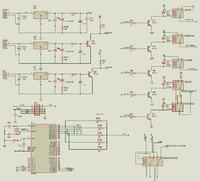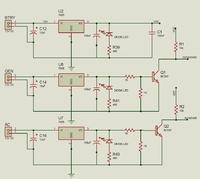tariq.sahi
Junior Member level 2
Hellow all i have designed generator automated transfer system. it is based on 89s51 which controls the operation. circuit uses LM7805 with 10uf16v before and 100uf16v after the regulator. i have also used 5.1v zener for protection against over voltage and 100pf for noise filtration. circuit senses 220v AC with the help of step down transformer and bridge rectifier. for the generator part it is available with 14v DC supply for secondary battery charging and i have used it to determine that the generator has started. my circuit works fine when it is connected to a test supply it also works fine when generator is turned off and battery power is used for test purpose. to cut short the elaboration part when circuit starts the generator and generator power led turns on but after some a while MCU seems to have stuck up as it turn of the switch relay causing the generator to shutoff. and when the generator is off it does not attempt to restart unless reset button is pressed. kindly help me with the issue as it is beyond my comprehension and i don't have scope to see what exactly is happening to the input voltage.


